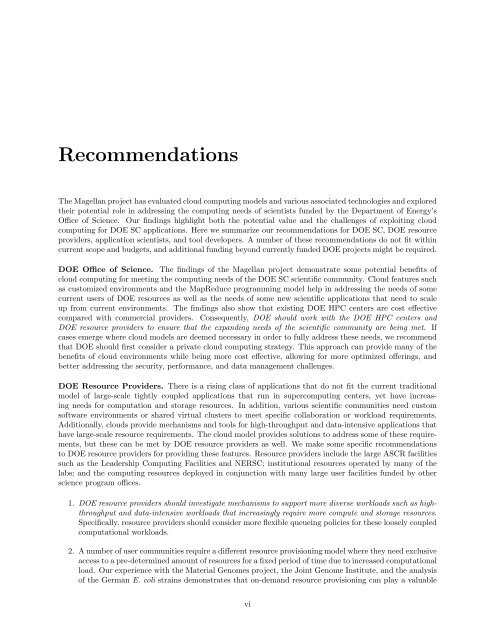Magellan Final Report - Office of Science - U.S. Department of Energy
Magellan Final Report - Office of Science - U.S. Department of Energy
Magellan Final Report - Office of Science - U.S. Department of Energy
You also want an ePaper? Increase the reach of your titles
YUMPU automatically turns print PDFs into web optimized ePapers that Google loves.
Recommendations<br />
The <strong>Magellan</strong> project has evaluated cloud computing models and various associated technologies and explored<br />
their potential role in addressing the computing needs <strong>of</strong> scientists funded by the <strong>Department</strong> <strong>of</strong> <strong>Energy</strong>’s<br />
<strong>Office</strong> <strong>of</strong> <strong>Science</strong>. Our findings highlight both the potential value and the challenges <strong>of</strong> exploiting cloud<br />
computing for DOE SC applications. Here we summarize our recommendations for DOE SC, DOE resource<br />
providers, application scientists, and tool developers. A number <strong>of</strong> these recommendations do not fit within<br />
current scope and budgets, and additional funding beyond currently funded DOE projects might be required.<br />
DOE <strong>Office</strong> <strong>of</strong> <strong>Science</strong>. The findings <strong>of</strong> the <strong>Magellan</strong> project demonstrate some potential benefits <strong>of</strong><br />
cloud computing for meeting the computing needs <strong>of</strong> the DOE SC scientific community. Cloud features such<br />
as customized environments and the MapReduce programming model help in addressing the needs <strong>of</strong> some<br />
current users <strong>of</strong> DOE resources as well as the needs <strong>of</strong> some new scientific applications that need to scale<br />
up from current environments. The findings also show that existing DOE HPC centers are cost effective<br />
compared with commercial providers. Consequently, DOE should work with the DOE HPC centers and<br />
DOE resource providers to ensure that the expanding needs <strong>of</strong> the scientific community are being met. If<br />
cases emerge where cloud models are deemed necessary in order to fully address these needs, we recommend<br />
that DOE should first consider a private cloud computing strategy. This approach can provide many <strong>of</strong> the<br />
benefits <strong>of</strong> cloud environments while being more cost effective, allowing for more optimized <strong>of</strong>ferings, and<br />
better addressing the security, performance, and data management challenges.<br />
DOE Resource Providers. There is a rising class <strong>of</strong> applications that do not fit the current traditional<br />
model <strong>of</strong> large-scale tightly coupled applications that run in supercomputing centers, yet have increasing<br />
needs for computation and storage resources. In addition, various scientific communities need custom<br />
s<strong>of</strong>tware environments or shared virtual clusters to meet specific collaboration or workload requirements.<br />
Additionally, clouds provide mechanisms and tools for high-throughput and data-intensive applications that<br />
have large-scale resource requirements. The cloud model provides solutions to address some <strong>of</strong> these requirements,<br />
but these can be met by DOE resource providers as well. We make some specific recommendations<br />
to DOE resource providers for providing these features. Resource providers include the large ASCR facilities<br />
such as the Leadership Computing Facilities and NERSC; institutional resources operated by many <strong>of</strong> the<br />
labs; and the computing resources deployed in conjunction with many large user facilities funded by other<br />
science program <strong>of</strong>fices.<br />
1. DOE resource providers should investigate mechanisms to support more diverse workloads such as highthroughput<br />
and data-intensive workloads that increasingly require more compute and storage resources.<br />
Specifically, resource providers should consider more flexible queueing policies for these loosely coupled<br />
computational workloads.<br />
2. A number <strong>of</strong> user communities require a different resource provisioning model where they need exclusive<br />
access to a pre-determined amount <strong>of</strong> resources for a fixed period <strong>of</strong> time due to increased computational<br />
load. Our experience with the Material Genomes project, the Joint Genome Institute, and the analysis<br />
<strong>of</strong> the German E. coli strains demonstrates that on-demand resource provisioning can play a valuable<br />
vi

















